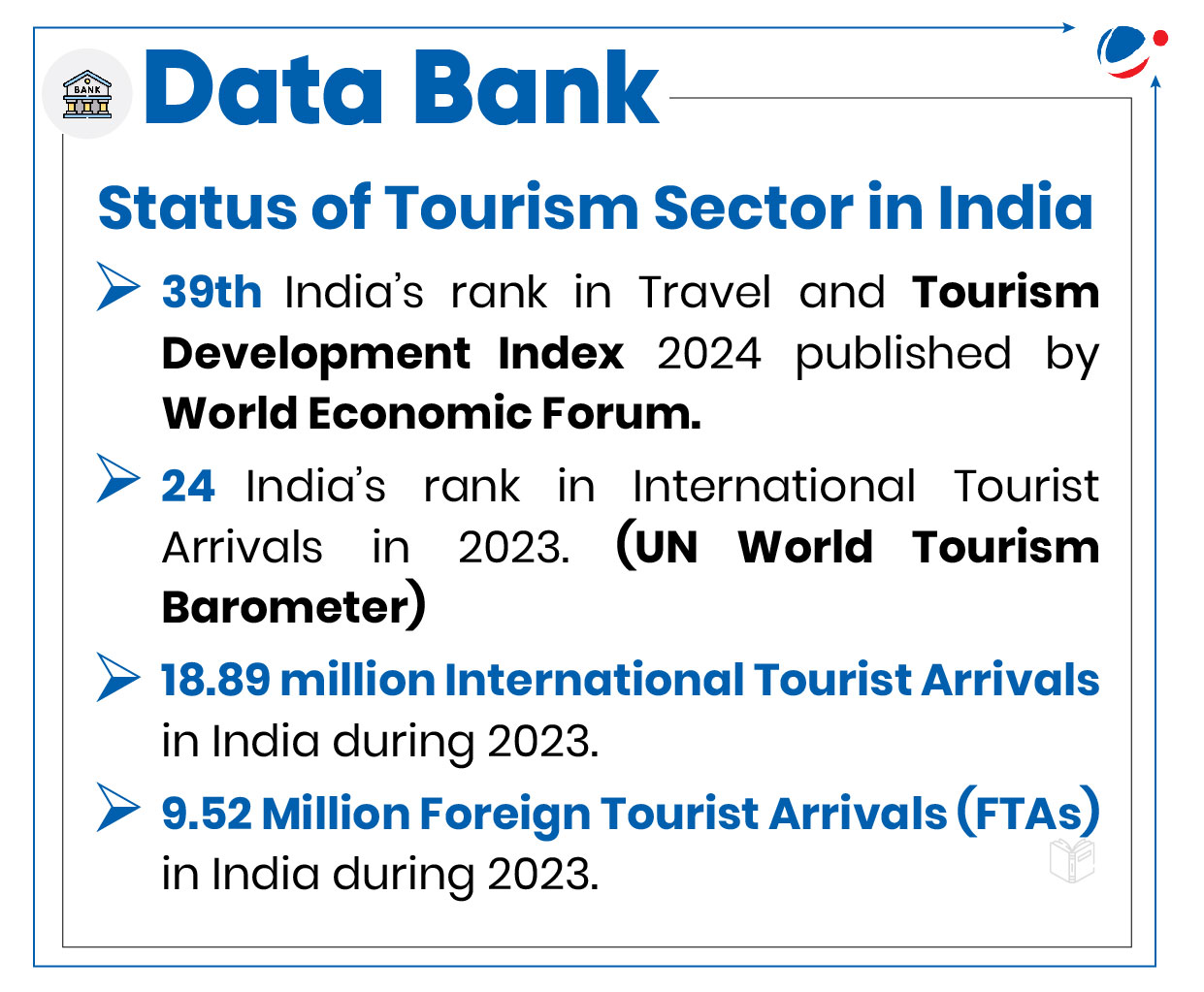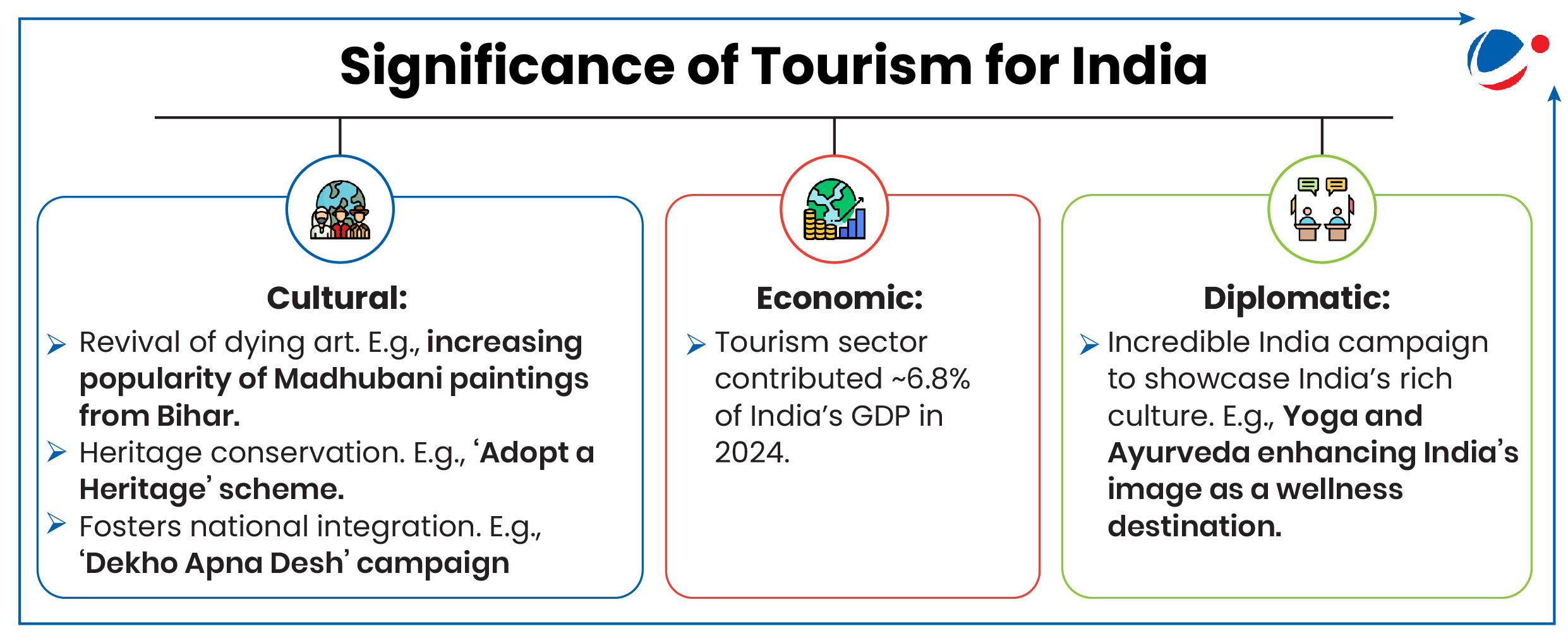Why in the News?

Recently, Union Ministry of Tourism has approved 40 Projects worth ₹ 3295.76 Crore for development of lesser-known Tourism sites in 23 States.
More on the News
- The initiative aims to ease pressure on high-traffic sites, promote balanced tourist distribution, enhance experiences, boost local economies, and ensure sustainable tourism growth by enhancing tourism infrastructure in the country.
- Projects are aligned with the Ministry of Tourism's guidelines for Development of Iconic Tourist Centres to Global Scale for developing Iconic Tourist Centres under Special Assistance to States/Union Territories for Capital Investment (SASCI) Scheme of Department of Expenditure, Union Ministry of Finance.
- SASCI Scheme, first announced in the Union Budget 2020-21, provides 50-year interest-free loans to state governments for capital projects, including developing iconic tourist centers and promoting them globally.

Challenges in Tourism Sector
- Infrastructure bottlenecks: Inadequate road, rail, and air connectivity to remote tourist destinations, sub-optimal availability of clean restrooms, drinking water, and signage at tourist sites, etc.
- E.g., 41% of stakeholders cite lack of infrastructure as a key barrier to boosting tourist footfall in India. (Union Ministry of Tourism Assessment, 2023)
- Safety and security concerns: Frequently reported incidents of harassment, theft, and scams targeting tourists; perceived risks to women's safety deter solo female travelers, especially international tourists; etc.
- Environmental degradation: Excessive and unregulated tourist footfall in eco-sensitive areas like Himalayan region leads to habitat destruction, pollution, and strain on resources.
- Further, lack of proper waste disposal systems in popular tourist destinations leads to degradation of watersheds and natural ecosystems. E.g., Hill stations like Manali suffering from littering.
- Seasonality of tourism: High fluctuations in tourism activities in different seasons lead to various problem like overcrowding, lack of services, and sub-optimal utilization of facilities in off-seasons, affecting profitability.
- E.g., Char Dham Pilgrimage in Uttarakhand.
- Post-Pandemic Recovery Issues: According to the UN Tourism Barometer, Asia and the Pacific reached only 85% of 2019 levels in international arrivals from January to September 2024.
Initiatives to promote Tourism in India
|
Way Forward
- Enhancing connectivity and accessibility: Promote transit-oriented development, make tourist destinations and cities walkable and cyclable, develop tourist-friendly amenities like multilingual signage, Wi-Fi zones, etc. to improve last-mile connectivity.
- Promotion of Niche tourism: Promote farm stays and cultural tourism in rural areas to empower local communities.
- Create wellness clusters in states like Uttarakhand, Kerala, etc.; facilitate single-window clearances for filming permissions to global film industry, etc.
- Sustainable tourism: Clear zoning of landscape (Land Use Plan based on maps and stakeholder interests) to monitor and guide site specific interventions, if and when required.
- Environmental audit of tourism service providers based on environment efficiency and carbon generation and certification.
- Pro-active monitoring and public reporting of environmental, economic, social, and tourism strategies, milestones and issues in sync with SDG Targets and Indicators.
- Leveraging technology: Develop AI-powered tourist platforms for personalized travel planning and real-time assistance. E.g., Integrating Augmented Reality for virtual walkthroughs of monuments.
- Use IoT, Big Data, satellite-mapping, etc., for better management of tourist flow, multi-hazard zonation, and optimal resource allocation.






